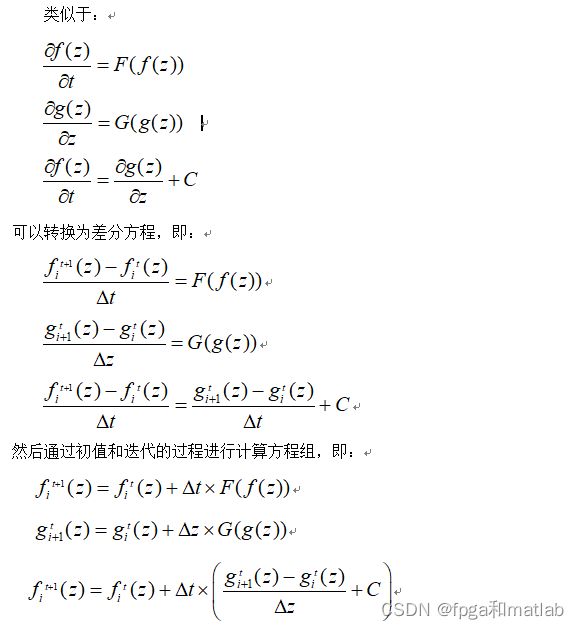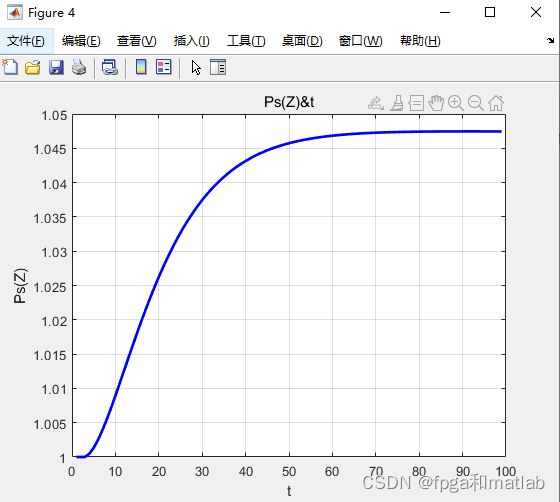基于差分迭代发求解离散微分方程的matlab仿真
目录
一、理论基础
二、MATLAB仿真程序
三、仿真结果
一、理论基础
这类复杂方程组,其解方程通常不能直接使用MATLAB内部的自带函数进行求解,往往需要使用别的算法进行,本课题涉及到的方程组的基本类型如下所示:
“连续微分方程”到“离散微分方程”到“差分方程”,离散微分方程,变成差分方程。建立差分方程时,时间采用一阶显格式,空间采用一阶偏心差分格式。
二、MATLAB仿真程序
clc;
clear;
close all;
warning off;
%%%%%%%%%%%%%%%%%%%%%%%%%%%%%%%%%%%%%%%%%%%%%%%%%%%
Vj = 1.0e14*[2.037671762107052
2.034215151823580
2.030770248941575
2.027336994082841
2.023915328270042
2.020505192923336
2.017106529857023
2.013719281276238
2.010343389773680
2.006978798326360
2.003625450292398
2.000283289407840
1.996952259783514
1.993632305901912
1.990323372614108
1.987025405136702
1.983738349048801
1.980462150289017
1.977196755152515
1.973942110288066
1.970698162695152
1.967464859721083
1.964242149058149
1.961029978740801
1.957828297142857
1.954637052974735
1.951456195280716
1.948285673436231
1.945125437145175
1.941975436437247
1.938835621665319
1.935705943502825
1.932586352941177
1.929476801287208
1.926377240160643
1.923287621491580
1.920207897518015
1.917138020783374
1.914077944134078
1.911027620717132
1.907987003977725
1.904956047656871
1.901934705789056
1.898922932699921];
DVj = 1.0e+011*[3.462483877836962
3.450746652796573
3.439069007521719
3.427450539446898
3.415890849400914
3.404389541572597
3.392946223476911
3.381560505921475
3.370232002973479
3.358960331926962
3.347745113270506
3.336585970655279
3.325482530863469
3.314434423777078
3.303441282347068
3.292502742562887
3.281618443422334
3.270788026901764
3.260011137926652
3.249287424342494
3.238616536886035
3.227998129156823
3.217431857589106
3.206917381424041
3.196454362682216
3.186042466136488
3.175681359285135
3.165370712325313
3.155110198126804
3.144899492206068
3.134738272700597
3.124626220343543
3.114563018438641
3.104548352835411
3.094581911904646
3.084663386514161
3.074792470004828
3.064968858166864
3.055192249216406
3.045462343772321
3.035778844833293
3.026141457755156
3.016549890228479
3.007003852256406];
F_ASE_vj = [0.727687625579220
0.726884730352238
0.726081696237599
0.725278527912882
0.724475230042399
0.723671807275757
0.722868264249905
0.722064605587050
0.721260835896694
0.720456959773481
0.719652981799073
0.718848906541101
0.718044738553185
0.717240482375278
0.716436142533662
0.715631723540323
0.714827229893890
0.714022666078659
0.713218036565208
0.712413345810112
0.711608598256263
0.710803798332059
0.709998950452820
0.709194059019136
0.708389128418137
0.707584163022211
0.706779167191096
0.705974145268722
0.705169101586599
0.704364040461595
0.703558966196364
0.702753883079915
0.701948795386920
0.701143707377818
0.700338623299606
0.699533547384828
0.698728483851725
0.697923436905154
0.697118410735281
0.696313409518148
0.695508437416143
0.694703498577095
0.693898597135282
0.693093737210495];
O12_vj = 1.0e-24*[ 0.11
0.13
0.175
0.215
0.3
0.275
0.288
0.31
0.33
0.34
0.335
0.33
0.335
0.33
0.303
0.28
0.25
0.25
0.248
0.26
0.268
0.28
0.325
0.425
0.57
0.628
0.53
0.426
0.388
0.35
0.31
0.25
0.24
0.22
0.195
0.17
0.15
0.14
0.118
0.1
0.078
0.068
0.06
0.059];
O21_vj = 1.0e-24*[ 0.05
0.06
0.07
0.095
0.11
0.13
0.15
0.16
0.18
0.2
0.21
0.218
0.23
0.231
0.23
0.228
0.217
0.218
0.225
0.246
0.275
0.318
0.378
0.51
0.76
0.89
0.725
0.638
0.618
0.58
0.527
0.485
0.49
0.475
0.42
0.39
0.365
0.346
0.305
0.262
0.221
0.195
0.17
0.169];
%参数初始化
Vp = 3.074794441025641e14;
Vs = 1.955593333333334e14;
DVs = 3.186042466136488e11;
h = 6.626e-34;
Ac = 10.5625e-12;
Fp = 0.8773;
Fs = 0.7078;
NEr = 1.5e26;
NYb = 1.9e27;
O12_vs = 6.5e-25;
O21_vs = 9.0e-25;
O13_vp = 2.58e-25;
O31_vp = 0;
O12Yb_vp= 1.0e-24;
O21Yb_vp= 1.0e-24;
r21 = 7.9e-3; A21 = 1/r21;
r32 = 1.0e-9; A32 = 1/r32;
r43 = 1.0e-9; A43 = 1/r43;
r21Yb = 2.0e-3; A21Yb = 1/r21Yb;
C2 = 5.0e-23;
C3 = 5.0e-23;
C14 = 3.5e-23;
Ktr = 2.0e-22;
Kba = 0;
ap = 0;
as = 0;
M = 44;
%其余参数初始化
L = 0.05; %空间长度
time = 1e-8; %时间长度
Nz = 100; %空间点数
Nt = 100; %时间网点数
dt = time/Nt;%t微分导数累计量
dz = L/Nz;%z微分导数累计量
N1 = zeros(Nz,Nt);
N2 = zeros(Nz,Nt);
N3 = zeros(Nz,Nt);
N4 = zeros(Nz,Nt);
N1_Yb = zeros(Nz,Nt);
N2_Yb = zeros(Nz,Nt);
Ps = zeros(Nz,Nt);
PASE_plus = zeros(M,Nz,Nt);
PASE_minus = zeros(M,Nz,Nt);
Pp_plus = zeros(Nz,Nt);
Pp_minus = zeros(Nz,Nt);
G = zeros(Nz,Nt);
NF = zeros(Nz,Nt);
%方程组1的式子1复杂系数的参数表示
W11 = Fp*O13_vp/(Ac*h*Vp);
W12 = Fs*O12_vs/(Ac*h*Vs);
for i = 1:M
W13(i) = F_ASE_vj(i) * O12_vj(i) / (Ac*h*Vj(i));
end
W14 = Fs*O21_vs/(Ac*h*Vs);
for i = 1:M
W15(i) = F_ASE_vj(i) * O21_vj(i) / (Ac*h*Vj(i));
end
W16 = Fp*O31_vp/(Ac*h*Vp);
%方程组1的式子2复杂系数的参数表示
W21 = Fs*O12_vs/(Ac*h*Vs);
for i = 1:M
W22(i) = F_ASE_vj(i) * O21_vj(i) / (Ac*h*Vj(i));
end
W23 = Fs*O21_vs/(Ac*h*Vs);
for i = 1:M
W24(i) = F_ASE_vj(i) * O21_vj(i) / (Ac*h*Vj(i));
end
%方程组1的式子3复杂系数的参数表示
W31 = Fp*O13_vp/(Ac*h*Vp);
W32 = Fp*O31_vp/(Ac*h*Vp);
%方程组1的式子4复杂系数的参数表示
W41 = Fp*O12Yb_vp/(Ac*h*Vp);
W42 = Fp*O21Yb_vp/(Ac*h*Vp);
Ps(1,:) = ones(1,Nt);
Pp_plus(1,:) = ones(1,Nt);
Pp_minus(1,:) = ones(1,Nt);
for j = 1:Nt-1
for i = 1:Nz-1
%方程组1式子1
N1(i,j+1) = N1(i,j) + ...
dt*( -1*(W11*(Pp_plus(i,j) + Pp_minus(i,j)) + W12*Ps(i,j) + sum(W13.*(PASE_plus(:,i,j)+PASE_minus(:,i,j))'))*N1(i,j) +...
(A21 + W14*Ps(i,j) + sum(W15.*(PASE_plus(:,i,j)+PASE_minus(:,i,j))'))*N2(i,j) + ...
C2*N2(i,j)^2 + W16*(Pp_plus(i,j) + Pp_minus(i,j))*N3(i,j) + C3*N3(i,j)^2 - C14*N1(i,j)*N4(i,j)+...
-1*Ktr*N2_Yb(i,j)*N1(i,j)+Kba*N1_Yb(i,j)*N3(i,j) );
%方程组1式子2
N2(i,j+1) = N2(i,j) + ...
dt*( (W21*Ps(i,j)+sum(W22.*(PASE_plus(:,i,j)+PASE_minus(:,i,j))'))*N1(i,j) +...
-1*(A21 + W23*Ps(i,j) + sum( W24.*(PASE_plus(:,i,j)+PASE_minus(:,i,j))' ))*N2(i,j) +...
A32*N3(i,j) - 2*C2*N2(i,j)^2 + 2*C14*N1(i,j)*N4(i,j) );
%方程组1式子3
N3(i,j+1) = N3(i,j) + ...
dt*( W31*(Pp_plus(i,j) + Pp_minus(i,j))*N1(i,j) - A32*N3(i,j) - W32*(Pp_plus(i,j) + Pp_minus(i,j))*N3(i,j) -...
2*C3*N3(i,j)^2 + A43*N4(i,j) + Ktr*N2_Yb(i,j)*N1(i,j) - Kba*N1_Yb(i,j)*N3(i,j) );
%方程组1式子4
N1_Yb(i,j+1) = N1_Yb(i,j) + ...
dt*(-1*W41*(Pp_plus(i,j) + Pp_minus(i,j))*N1_Yb(i,j) + W42*(Pp_plus(i,j) + Pp_minus(i,j))*N2_Yb(i,j) +...
A21Yb*N2_Yb(i,j) + Ktr*N2_Yb(i,j)*N1(i,j) - Kba*N1_Yb(i,j)*N3(i,j));
%方程组1式子5
N4(i,j+1) = NEr - (N1(i,j+1) + N2(i,j+1) + N3(i,j+1));
%方程组1式子6
N2_Yb(i,j+1) = NYb - N1_Yb(i,j+1);
if N1(i,j+1) > NEr,N1(i,j+1) = NEr;end
if N2(i,j+1) > NEr,N2(i,j+1) = NEr;end
if N3(i,j+1) > NEr,N3(i,j+1) = NEr;end
if N4(i,j+1) > NEr,N4(i,j+1) = NEr;end
if N1_Yb(i,j+1) > NYb,N1_Yb(i,j+1) = NYb;end
if N2_Yb(i,j+1) > NYb,N2_Yb(i,j+1) = NYb;end
if N1(i,j+1) < 0,N1(i,j+1) = 0;end
if N2(i,j+1) < 0,N2(i,j+1) = 0;end
if N3(i,j+1) < 0,N3(i,j+1) = 0;end
if N4(i,j+1) < 0,N4(i,j+1) = 0;end
if N1_Yb(i,j+1) < 0,N1_Yb(i,j+1) = 0;end
if N2_Yb(i,j+1) < 0,N2_Yb(i,j+1) = 0;end
%由以上方程计算得到的N1,N2,N3,N4,N1Yb,N2Yb
%方程组2
Pp_plus(i+1,j) = Pp_plus(i,j) + dz*(-Fp*(O13_vp*N1(i,j) - O31_vp*N3(i,j) + O12Yb_vp*N1_Yb(i,j) - O21Yb_vp*N2_Yb(i,j))*Pp_plus(i,j) - ap*Pp_plus(i,j));
Pp_minus(i+1,j) = Pp_minus(i,j) + dz*(Fp*(O13_vp*N1(i,j) - O31_vp*N3(i,j) + O12Yb_vp*N1_Yb(i,j) - O21Yb_vp*N2_Yb(i,j))*Pp_minus(i,j) + ap*Pp_plus(i,j));
Ps(i+1,j) = Ps(i,j) + dz*(Fs*( O21_vs*N2(i,j) - O12_vs*N1(i,j) )*Ps(i,j) - as*Ps(i,j));
%PASE_plus = zeros(M,Nz,Nt);
%PASE_minus = zeros(M,Nz,Nt);
for ii = 1:M
PASE_plus(ii,i+1,j) = PASE_plus(ii,i,j)+dz*(F_ASE_vj(ii)*( O21_vj(ii)*N2(i,j) - O12_vj(ii)*N1(i,j) ) * PASE_plus(ii,i,j) +...
2*h*Vj(ii)*DVj(ii)*F_ASE_vj(ii)*O21_vj(ii)*N2(i,j)-as*PASE_plus(ii,i,j));
PASE_minus(ii,i+1,j) = PASE_minus(ii,i,j)+dz*(-1*F_ASE_vj(ii)*( O21_vj(ii)*N2(i,j) - O12_vj(ii)*N1(i,j) ) * PASE_minus(ii,i,j) -...
2*h*Vj(ii)*DVj(ii)*F_ASE_vj(ii)*O21_vj(ii)*N2(i,j)+as*PASE_minus(ii,i,j));
end
if Pp_plus(i+1,j) < 0,Pp_plus(i+1,j) = 0;end
if Pp_minus(i+1,j) < 0,Pp_minus(i+1,j) = 0;end
if Ps(i+1,j) < 0,Ps(i+1,j) = 0;end
%通过稳态计算得到Pp+,Pp-,Pase+,Pase-,Ps
end
end
for z = 1:Nz
for t = 1:Nt
PASE_plus2(z,t) = sum(PASE_plus(:,z,t));
PASE_minus2(z,t) = sum(PASE_minus(:,z,t));
end
end
for z = 1:Nz
for t = 1:Nt
G(z,t) = 10*log10(Ps(z,t)/Ps(1,1));
end
end
for z = 1:Nz
for t = 1:Nt
NF(z,t) = 10*log10(1/G(z,t) + PASE_plus2(z,t)/(G(z,t)*Vs*DVs) );
end
end
%计算得到N1~t,N2~t,N3~t,N4~t,........
figure;
subplot(221);
plot(N1(1,2:end),'b-','LineWidth',2);
xlabel('t');
ylabel('N1(Z)');
title('N1(Z)&t');
grid on;
subplot(222);
plot(N2(1,2:end),'b-','LineWidth',2);
xlabel('t');
ylabel('N2(Z)');
title('N2(Z)&t');
grid on;
subplot(223);
plot(N3(1,2:end),'b-','LineWidth',2);
xlabel('t');
ylabel('N3(Z)');
title('N3(Z)&t');
grid on;
subplot(224);
plot(N4(1,2:end),'b-','LineWidth',2);
xlabel('t');
ylabel('N4(Z)');
title('N4(Z)&t');
grid on;
%%%%%%%%%%%%%%%%%%%%%%%%%%%%%%%%%%%%%%%%%%%%%%%%%%%%%%%%%%%%%%%%%%%%%%%%%%%
figure;
subplot(211);
plot(N1_Yb(1,2:end),'b-','LineWidth',2);
xlabel('t');
ylabel('N1Yb(Z)');
title('N1Yb(Z)&t');
grid on;
subplot(212);
plot(N2_Yb(1,2:end),'b-','LineWidth',2);
xlabel('t');
ylabel('N2Yb(Z)');
title('N2Yb(Z)&t');
grid on;
%%%%%%%%%%%%%%%%%%%%%%%%%%%%%%%%%%%%%%%%%%%%%%%%%%%%%%%%%%%%%%%%%%%%%%%%%%%
figure;
subplot(211);
plot(PASE_plus2(3,1:end-2),'b-','LineWidth',2);
xlabel('t');
ylabel('PASE+(Z)');
title('PASE+(Z)&t');
grid on;
subplot(212);
plot(PASE_minus2(3,1:end-2),'b-','LineWidth',2);
xlabel('t');
ylabel('PASE-(Z)');
title('PASE-(Z)&t');
grid on;
%%%%%%%%%%%%%%%%%%%%%%%%%%%%%%%%%%%%%%%%%%%%%%%%%%%%%%%%%%%%%%%%%%%%%%%%%%%
figure;
plot(Ps(2,1:end-1),'b-','LineWidth',2);
xlabel('t');
ylabel('Ps(Z)');
title('Ps(Z)&t');
grid on;
%%%%%%%%%%%%%%%%%%%%%%%%%%%%%%%%%%%%%%%%%%%%%%%%%%%%%%%%%%%%%%%%%%%%%%%%%%%
figure;
subplot(211);
plot(Pp_plus(20,3:end-1),'b-','LineWidth',2);
xlabel('t');
ylabel('Pp+(Z)');
title('Pp+(Z)&t');
grid on;
subplot(212);
plot(Pp_minus(20,3:end-1),'b-','LineWidth',2);
xlabel('t');
ylabel('Pp-(Z)');
title('Pp-(Z)&t');
grid on;
figure;
subplot(211);
plot(Pp_plus(1:end,6),'b-','LineWidth',2);
xlabel('t');
ylabel('Pp+(Z)');
title('Pp+(Z)&t');
grid on;
subplot(212);
plot(Pp_minus(1:end,6),'b-','LineWidth',2);
xlabel('t');
ylabel('Pp-(Z)');
title('Pp-(Z)&t');
grid on;
%%%%%%%%%%%%%%%%%%%%%%%%%%%%%%%%%%%%%%%%%%%%%%%%%%%%%%%%%%%%%%%%%%%%%%%%%%%
figure;
plot(G(20,3:end-1),'b-','LineWidth',2);
xlabel('t');
ylabel('G(Z)dB');
title('G(Z)&t');
grid on;
%%%%%%%%%%%%%%%%%%%%%%%%%%%%%%%%%%%%%%%%%%%%%%%%%%%%%%%%%%%%%%%%%%%%%%%%%%%
figure;
plot(NF(2,3:end-1),'b-','LineWidth',2);
xlabel('t');
ylabel('NF(Z)dB');
title('NF(Z)&t');
grid on;
三、仿真结果
A16-15






